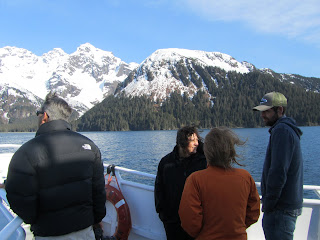I had the pleasure this week to join some 1300 marine scientists, educators and conservationists at the second dedicated marine conservation congress organized under the auspices of the Society for Conservation Biology (SCB). There have been several past efforts to establish an international flagship conference for marine conservation and it really looks like the IMCC concept has lots of "stickiness"! This is likely a result of the rapidly growing global investments in marine research, education and conservation. The Convention on Biodiversity target to establish 10% of the world's oceans in MPAs by 2012 is not likely to be met... but it has stimulated an incredible global marine conservation effort over the past 5 years especially.
IMCC2 was a veritable banquet of knowledge sharing - there were literally dozens of difficult menu choices to make every day. From light appertisers to full meals, it really was tough to select from the range of offerings - the program is available on the congress website -
http://www.conbio.org/imcc2011/.
Three highlights for me were:
1. Our Pre-congress full day session on
citizen science in support of marine conservation - last Friday we held a workshop featuring some 14 different global citizen science projects that was a follow up to the Coastal America Coastal Ecosystem Learning Centers meeting with the North American Protected Areas Network initiative - we have further follow up planned for the Coastal America meeting in July and have identified several areas of potential cooperation between West Coast aquaria;
2. Seeing the dramatic advances in global
marine planning - these ranged from various updates on key software such as Marxan to many novel applications of marine planning to promote both conservation and livelihood objectives - there is an amazing amount of innovation underway that has great relevance to the North Pacific and to the research, education and steweardship mission of the Alaska SeaLife Center;
3. The increasing role of
social sciences in marine conservation and research - there were numerous sessions that demonstrated unequivocally that all marine initiatives need to incorporate appropriate consideration of the human dimensions of ocean use, particularly governance arrangements. One particular session on the future of Arctic fisheries bought into sharp focus the relevance of the increasing arctic research of the ASLC (and the need to expand our research efforts in the Arctic) and the need for new partnerships to provide that science.
IMCC2 was also a wonderful opportunity to network with colleagues who I have worked with over the past 25 years - from my Great Barrier Reef Days to Indonesia and Pacific partners to my current role in Arctic research and education, an event like IMCC2 is a great way to draw together the many threads of knowledge that I have contributed to and learned from! I especially enjoyed the various synthesis sessions where we sought to distil trends and set agendas for future research...
Like all large conferences, IMCC2 suffered from some limitations - there was perhaps an over emphasis on "academic" presentations and an under-representation of field practitioner knowledge. There was also an inherent bias towards knowledge generated in developed countries and by researchers from developed countries (perhaps understandable given the venue in Canada). However, these were fairly minor criticisms given the overall emphasis on advancing science that matters.
I would encourage all ASLC staff and partners to have a look through the congress proceedings and to join me in thinking about what our contribution will be to IMCC3... above all, IMCC2 reinforced in my mind that the science being undertaken at the ASLC does matter and is very relevant to the future diversity and quality of life on earth!
Oh... and I should acknowledge the value of holding a conference in a setting that underscores the relevance of the topics discussed and inspires further inquiry - places matter and Victoria in BC was a wonderful setting for this event!










